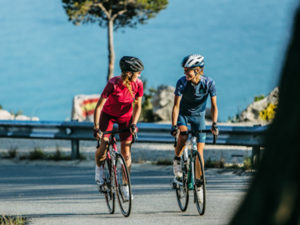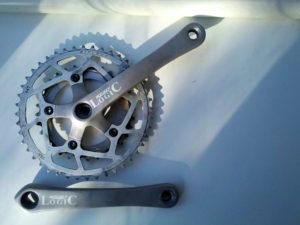
Photo by WikipediaCommon
Fine-tuning, recovery and hills!
We hope you’ve been able to get out and ride some; it’s been a challenging spring. No matter how much training you’ve been able to get in, there comes a time for the last push before the tour.
We’ve got just about two weeks until the Montana ride, and about five weeks until the Oregon ride, so now’s the time to start fine-tuning your training and looking at the specifics of our rides. In addition to being sure your equipment (bike, tent/sleeping bag/pad, bike clothing) is well suited to you and your riding style, we need to look at the terrain on each of the rides.
The Montana ride this year is a total of 378 miles with 22,750-plus feet of elevation gain (if you do the layover ride). That doesn’t seem like much gain – but it’s mostly all packed into two days. Day 2 over Beartooth Pass has 7,450 feet of climbing over 64 miles; that’s formidable. Then, after a day off, Chief Joseph Pass on Day 4 is 5,900 feet over a longer 77 miles. Both days are tests of pacing, hydration and nutrition. Beartooth in particular is one long and steady climb that will require you to keep fueling – don’t wait for the top. We’ll have rest and water stops along the way, and be sure to stock up on some pocket foods at the first rest stop. The good news is that after the second rest stop, there’s a long downhill, with just one good-size bump before the finish.

Photo by Albert Gallego Rabert
The Oregon ride is 435 miles with 24,300 feet of climbing (if you ride the layover option), so more total mileage and roughly the same climbing. There isn’t one punishing day; the routes are pretty much all between 3,000 and 4,000 feet, and Day 7 is relatively flat.
So what does this all mean for your training? Get some hills, and get some distance. So, how to ride hills and distances without pushing so hard that you go over your limit and can’t recover?
First and foremost, the whole power/weight ratio does matter. For every extra pound of weight you carry up a hill, you have to push a higher power level. But let's not go on any crash diets to cut back on body weight; that’s something you have to do slowly. (You can also go buy a $15,000, 14-pound road bike, but that’s expensive and impractical.)
So, what can you do in the next few weeks to get yourself ready for the hills? In addition to watching your diet by decreasing high-caloric food and beverages that may not be “needed” to help you train and recover (beer, desserts, chips… you get the picture), here are few things we recommend:
- Ride more hills. Yes that’s obvious, but here’s the caveat: You need to ride more hills without trashing yourself. So how do you do that? For your longer endurance rides, make it as hilly as possible, but while you’re on the hills keep your HR under 75-80% of your max (or a perceived effort of 5 or 6 on a scale of 10). Yes, you may get passed by people you don’t like to get passed by, but it will train your body how to go up hills efficiently..
- While riding hills, practice what are called “standing intervals.” This is where you practice standing up on the climb while keeping your HR low. Yep, sounds like an oxymoron, but it works. You may find you’re spinning really slowly (RPMs under 60), but that’s OK. Stand up slowly, hold your core tight and monitor your HR (or perceived effort). As soon as your effort seems to go above 80% of your HR max, or above 6 on your perceived effort scale, sit down. Then recover, and if it’s a long hill, try again. Keep practicing this until you can stand for 5 minutes at a time without your HR going up. Yes, you may go slow uphill, but you’ll complete the long rides, and probably catch the faster climbers on the descents. Most people go harder when they stand than when seated; their HR spikes and they start breathing really hard, and by the time they get to the top of the hill they’re wasted. This is great if that’s all you plan to ride for the day, but as part of a long endurance event or bike tour you need to pace yourself and conserve your energy.
- Strengthen your core: One thing that can help you climb hills better is if you have a strong core. This will allow you to activate your core muscles when riding, so as not to have to rely solely on your legs. You can find some great core exercises for cycling here: https://www.bicycling.com/training/a20926123/7-core-moves-for-killer-climbing/
- Get more gears! Spinning at a higher cadence with a lower gear will give you the same power (power = force x velocity) as pushing a really hard gear at a lower cadence (RPM). But using a harder gear and lower cadence usually recruits your larger muscle groups (fast-twitch muscles), which requires more energy and is less efficient. Compact front chainrings (50/34) with a large rear cassette (up to 34) will give you a much larger range of gears to work with. And you can spin more easily, recruit smaller muscle groups and save energy. Not to mention it puts less stress on the knees.

Photo by Flickr
Next let’s talk about your training focus this month and next. The primary focus this month should be to maintain your endurance while you also continue to work on hill climbing at a tempo/endurance pace. Doing tempo effort is harder to recover from, so you must have easy days between tempo workouts. Also, you need to build up to longer tempo intervals, which has been a focus over the past couple months.
We recommend doing one endurance day the same length of time you’ve been doing (2-4 hours), while on the other long day you build by 5-10 miles until you get up to the mileage of the longest day on the tour – or more. Both tours have at least one 70-mile-plus day, so if you can get in one day of 70, 80, or even a century during the last 3-5 weeks before the tour, that will help you a lot. In addition to building fitness, it will help point out any weaknesses in your choice of clothing/saddle/bike fit.
For all your interval rides, be sure to get in a good warmup and cool-down. The shorter and harder the intervals, the longer the warmup needs to be. We recommend at least 30-45 minutes for warmup before doing any outdoor hill intervals.
As always, this is a guide that assumes you’ve been following our recommendations since the first 2023 blog in January. If not, go back to previous months’ blogs and review the training recommendations.
And, as always, don’t do any of these workouts unless you’ve been cleared by your healthcare provider to do hard efforts.
Happy riding, and see you soon!
This was adapted from a previous blog post by retired physician and professional performance trainer Anne Linton, who lives in Bend. If you’re interested in more in-depth coaching or training guidelines, feel free to email or go to her website at Linton Horner Coaching.